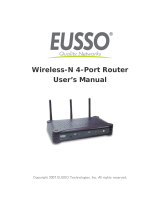
iiiD-Link DIR-685 User Manual
Table of Contents
Manual Wireless Connection Setup ................. 50
Wi-Fi Protected Setup ..................................51
Wireless Network Settings ........................... 52
Network Setup ................................................. 54
Router Settings ............................................55
DHCP Server Settings .................................56
DHCP Reservation .......................................57
LCD Screen ..................................................... 58
Port Forwarding ............................................... 59
Application Rules ............................................. 61
QoS Engine ..................................................... 62
Network Filter ................................................... 63
Website Filter ................................................... 64
Firewall Settings .............................................. 65
SPI ...............................................................65
NAT Endpoint Filter ......................................65
Anti-Spoof Check ......................................... 65
DMZ .............................................................65
SPI / DMZ Host ............................................ 66
SPI ...............................................................66
NAT Endpoint Filter ......................................66
Anti-Spoof Check ......................................... 66
DMZ .............................................................66
Firewall Rules ...............................................67
Routing ............................................................ 68
Advanced Wireless .......................................... 69
RTS Threshold .............................................69
DTIM Interval ................................................69
WMM Function .............................................69
Advanced Network ........................................... 70
UPnP ............................................................70
WAN Ping Block ...........................................70
WAN Port Speed ..........................................70
Multicast Streams .........................................70
Guest Zone ......................................................71
Wake on LAN ................................................... 73
Disk Management ............................................ 74
User / Groups .................................................. 75
Group List .....................................................76
Storage Access ................................................77
Network Access Lists ...................................79
Editing Existing Network Access Lists .........80
Deleting a Network Access List ....................82
FTP Server ...................................................... 83
FTP Server Settings .....................................84
FTP Access List ........................................... 85
Editing an FTP Access List .......................... 86
Deleting an FTP Access List ........................88
UPnP AV Server ..............................................89
iTunes Server .................................................. 90
BT Download Manager .................................... 91
Admin ...............................................................92
Change Password ........................................92
Remote Management ...................................92
Time ................................................................. 93
Log Settings ..................................................... 94
Email Settings .................................................. 95





















